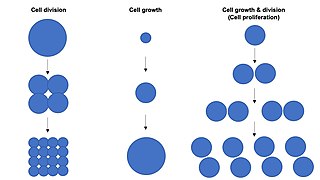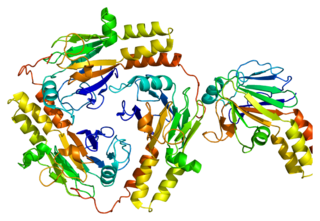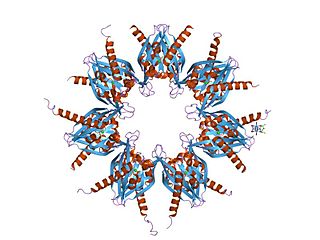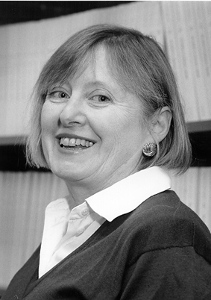Related Research Articles

Adenylate cyclase is an enzyme with systematic name ATP diphosphate-lyase . It catalyzes the following reaction:
FOXproteins are a family of transcription factors that play important roles in regulating the expression of genes involved in cell growth, proliferation, differentiation, and longevity. Many FOX proteins are important to embryonic development. FOX proteins also have pioneering transcription activity by being able to bind condensed chromatin during cell differentiation processes.

The mushroom bodies or corpora pedunculata are a pair of structures in the brain of insects, other arthropods, and some annelids. They are known to play a role in olfactory learning and memory. In most insects, the mushroom bodies and the lateral horn are the two higher brain regions that receive olfactory information from the antennal lobe via projection neurons. They were first identified and described by French biologist Félix Dujardin in 1850.

Cell proliferation is the process by which a cell grows and divides to produce two daughter cells. Cell proliferation leads to an exponential increase in cell number and is therefore a rapid mechanism of tissue growth. Cell proliferation requires both cell growth and cell division to occur at the same time, such that the average size of cells remains constant in the population. Cell division can occur without cell growth, producing many progressively smaller cells, while cell growth can occur without cell division to produce a single larger cell. Thus, cell proliferation is not synonymous with either cell growth or cell division, despite the fact that these terms are sometimes used interchangeably.

CREB-TF is a cellular transcription factor. It binds to certain DNA sequences called cAMP response elements (CRE), thereby increasing or decreasing the transcription of the genes. CREB was first described in 1987 as a cAMP-responsive transcription factor regulating the somatostatin gene.

Calcineurin (CaN) is a calcium and calmodulin dependent serine/threonine protein phosphatase. It activates the T cells of the immune system and can be blocked by drugs. Calcineurin activates nuclear factor of activated T cell cytoplasmic (NFATc), a transcription factor, by dephosphorylating it. The activated NFATc is then translocated into the nucleus, where it upregulates the expression of interleukin 2 (IL-2), which, in turn, stimulates the growth and differentiation of the T cell response. Calcineurin is the target of a class of drugs called calcineurin inhibitors, which include ciclosporin, voclosporin, pimecrolimus and tacrolimus.

Alfred Goodman Gilman was an American pharmacologist and biochemist. He and Martin Rodbell shared the 1994 Nobel Prize in Physiology or Medicine "for their discovery of G-proteins and the role of these proteins in signal transduction in cells."

Mothers against decapentaplegic homolog 1 also known as SMAD family member 1 or SMAD1 is a protein that in humans is encoded by the SMAD1 gene.

Ca2+
/calmodulin-dependent protein kinase II is a serine/threonine-specific protein kinase that is regulated by the Ca2+
/calmodulin complex. CaMKII is involved in many signaling cascades and is thought to be an important mediator of learning and memory. CaMKII is also necessary for Ca2+
homeostasis and reuptake in cardiomyocytes, chloride transport in epithelia, positive T-cell selection, and CD8 T-cell activation.

Pituitary adenylate cyclase-activating polypeptide also known as PACAP is a protein that in humans is encoded by the ADCYAP1 gene. pituitary adenylate cyclase-activating polypeptide is similar to vasoactive intestinal peptide. One of its effects is to stimulate enterochromaffin-like cells. It binds to vasoactive intestinal peptide receptor and to the pituitary adenylate cyclase-activating polypeptide receptor.

The GAL4-UAS system is a biochemical method used to study gene expression and function in organisms such as the fruit fly. It is based on the finding by Hitoshi Kakidani and Mark Ptashne, and Nicholas Webster and Pierre Chambon in 1988 that Gal4 binding to UAS sequences activates gene expression. The method was introduced into flies by Andrea Brand and Norbert Perrimon in 1993 and is considered a powerful technique for studying the expression of genes. The system has two parts: the Gal4 gene, encoding the yeast transcription activator protein Gal4, and the UAS, an enhancer to which GAL4 specifically binds to activate gene transcription.

A pair-rule gene is a type of gene involved in the development of the segmented embryos of insects. Pair-rule genes are expressed as a result of differing concentrations of gap gene proteins, which encode transcription factors controlling pair-rule gene expression. Pair-rule genes are defined by the effect of a mutation in that gene, which causes the loss of the normal developmental pattern in alternating segments.

Calcium/calmodulin-dependent protein kinase type II subunit alpha (CAMKIIα), a.k.a.Ca2+/calmodulin-dependent protein kinase II alpha, is one subunit of CamKII, a protein kinase (i.e., an enzyme which phosphorylates proteins) that in humans is encoded by the CAMK2A gene.

Calcium/calmodulin-dependent protein kinase type II gamma chain is an enzyme that in humans is encoded by the CAMK2G gene.

Adenylyl cyclase type 1 is an enzyme that in humans is encoded by the ADCY1 gene.

Adenylyl cyclase type 8 is an enzyme that in humans is encoded by the ADCY8 gene.

Notch proteins are a family of type-1 transmembrane proteins that form a core component of the Notch signaling pathway, which is highly conserved in metazoans. The Notch extracellular domain mediates interactions with DSL family ligands, allowing it to participate in juxtacrine signaling. The Notch intracellular domain acts as a transcriptional activator when in complex with CSL family transcription factors. Members of this Type 1 transmembrane protein family share several core structures, including an extracellular domain consisting of multiple epidermal growth factor (EGF)-like repeats and an intracellular domain transcriptional activation domain (TAD). Notch family members operate in a variety of different tissues and play a role in a variety of developmental processes by controlling cell fate decisions. Much of what is known about Notch function comes from studies done in Caenorhabditis elegans (C.elegans) and Drosophila melanogaster. Human homologs have also been identified, but details of Notch function and interactions with its ligands are not well known in this context.

Female-specific protein transformer is a protein that in Drosophila melanogaster is encoded by the tra gene. Unlike the related tra2 protein, it is only produced in females.

Eva Julia Neer (1937–2000) was an American physician, biochemist, and cell-biology scientist who gained U.S. national research awards for her discoveries on G-protein subunit structure and function. She described the physiological roles of these subunits as an integrated and versatile molecular system of signal transduction for membrane-receptor regulation of cell function. Her research concepts turned her into a world leader in G-protein studies and impinged widely on the general understanding of cell behavior.
Benjamin Weiss is an American neuropharmacologist, Emeritus Professor of Pharmacology and Physiology at Drexel University College of Medicine. He is best known for his work with cyclic nucleotide phosphodiesterases. He was the first to propose, based on his experimental work, that selective inhibition of phosphodiesterases which are expressed differentially in all tissues, could be used as a target for drug development. His work is the basis for many marketed and developmental human drugs that selectively inhibit cyclic nucleotide phosphodiesterases.
References
- ↑ Levin LR, Han PL, Hwang PM, Feinstein PG, Davis RL, Reed RR (February 1992). "The Drosophila learning and memory gene rutabaga encodes a Ca2+/Calmodulin-responsive adenylyl cyclase". Cell. 68 (3): 479–89. doi:10.1016/0092-8674(92)90185-F. PMID 1739965. S2CID 10739784.
- ↑ Livingstone MS, Sziber PP, Quinn WG (May 1984). "Loss of calcium/calmodulin responsiveness in adenylate cyclase of rutabaga, a Drosophila learning mutant". Cell. 37 (1): 205–15. doi: 10.1016/0092-8674(84)90316-7 . PMID 6327051.
- ↑ "FlyBase Gene Report: Dmel\rut". FlyBase. Retrieved 2008-09-27.